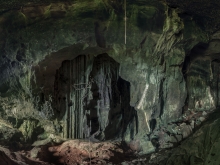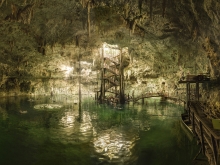Olaf Otto Becker
Under The Nordic Light










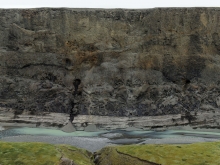


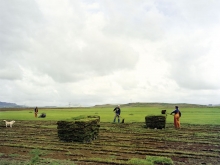






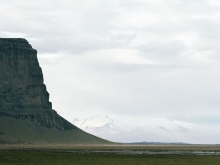
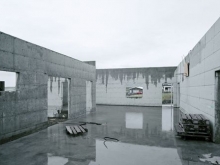
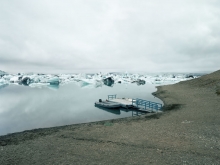







„For me, taking a photograph is the attempt to fully understand something. Understanding reality, that presents as landscape.“ OLAF OTTO BECKER, 2011
Olaf Otto Becker’s revisits of Iceland in the summer of 2010 and 2011 were a journey dedicated to the quest of finding traces of time. The work of his previous visits, between 1999 and 2002 got published in the 2005 book Under the Nordic Light. This year we are happy to present Under the Nordic Light – A Journey through Time (Hatje Cantz, 2011) – a comprehensive compendium of both projects.
„Can time be photographed?“ was a question and therefore working thesis of Olaf Otto Becker, resulting in photographs that deliberately frame the same places he depicted years before. The images of identic locations offer the rare and fascinating opportunity to experience time differently. The work is – in parts- presented as diptychs but in doing so it is not about providing before and after pictures but rather a visual test arrangement to revise one’s own perception.
„The same location twice: the same frame, the same light- in between ten years of our time; that is how I currently perceive myself. I am at the same time standing next to me as the witness of my own lifetime and surroundings only to then step out of time during the contemplation as if time did not even exist.“
Temporal experience, be it standstill or a constant, is mediated very differently. An obvious example, based on the visual interpretation of social factors, are the images of Iceland’s architectural development – in this term the country that got hit very hard by the global financial crisis seems to have not changed at all. In other cases the Icelandic natural landscape seems to adapt to or withdraw easily from the changes of time. But what exactly is the difference between the leadoff and „duplicate“ photograph? What makes the image unique? It may be a collection of experiences, associations, changed views and emotions that makes every new frame unique. It is the photographers view, as manifestation of cultural and socio –esthetical influences, that is getting revealed – possibly in photography like in no other medium.
But Becker must not necessarily be enqueued in the tradition of german photography of the last 25 years. His work it is not about portraying medial positions, as do most Becher epigones, he rather sees himself closer to the tradition of american landscape photography where the landscape can be taken as a stage of human existence. It is the focus on primordial landscapes, inherent to all of Becker’s projects, that centers the interaction or reciprocity of mankind and nature especially. Nature – untouched or man-made alteration – is the fundament of all being. The landscape, being the most obvious embodiment of nature and origin, is so powerful that it seems to adapt to all man made changes as if it were natures own productions.
Olaf Otto Becker works with a large format camera, a rather demanding process and an almost ceremonial act. It is a form of respect while approaching his subject. This reverence might be the key to understanding why looking at his photographs evokes instant comprehension of the beautiful and ephemeral. Without being accusatory Becker reminds us of the importance to feel the need for being respectful and in tune with our surroundings. What Olaf Otto Becker began in his previous projects Broken Line and Above Zero comes to an even more plausible and exciting conclusion in Under The Nordic Light – A Journey Through Time.
Above Zero











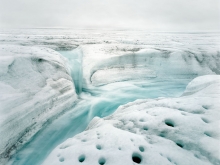




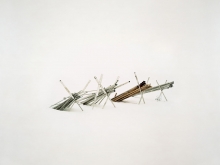


After Broken Line he returned to Greenland to complete another series of photographs for his new project Above Zero. This time his travels would take him even further into the land since he intended to portray the Greenland Ice Sheet, the vast body of ice covering the surface of Greenland. His goal to document the rivers, produced by the warmer summer time, is seen in the series Above Zero from 2009.
Equipped wit satellite pictures provided by NASA he made his way through the ice to seek out the spectacle of the melting ice surfaces. Temperatures Above Zero lead to rivers that find their way over and through the ice leaving a beautiful trace of both a natural and environmental phenomenon.
Olaf Otto Becker captured four rivers in all their beauty by documenting their courses through Greenland. The impressing images not only convince because of their composition, serene and beautiful colours but by stressing the qualities of photography when it comes to capturing time and legacy.
Broken Line
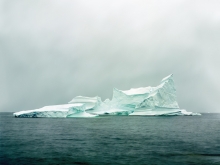







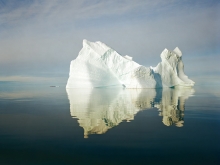

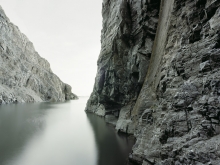



Between 2003 and 2006 Olaf Otto Becker travelled for his Project Broken Line almost 4000 km on his own along the West Coast of Greenland in a small dingy. The sole purpose of his trip was to portray this coastal region with his 8 x 10 inch large format camera.
Olaf Otto Becker reached the 75th Northern degree latitude with goals similar to the first arctic explorers of the 19th century. Beckers work is pervaded by the desire to find what lies beyond the easily visible – be it because of ist remote existence or his own unique perspective on the landscape. Becker portrays the landscape, accentuating its silence, melancholy and the sublime of a land known only to few. Each image has precise GPS data attached to it: seconds and minute degrees, similar to a scientific experimental set-up. Olaf Otto Becker's Ice landscapes of Greenland are documents of a quickly changing landscape where the traces and effects of climate change are becoming painfully visible.



